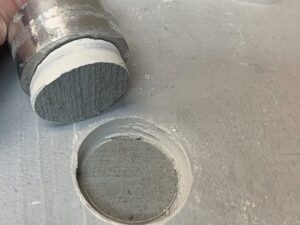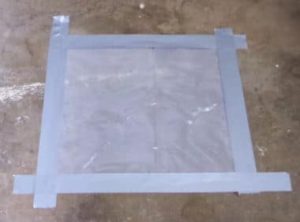By Sheldon White
Colloidal silica post-placement pozzolan technology fills capillary voids by reacting with calcium hydroxide found in concrete to form Calcium Silicate Hydrate (C-S-H). In this way, it improves the performance of coatings.
Most coatings that are placed on concrete, such as epoxies, urethanes, acrylics, polyurea and cementitious types, rely on mechanical bond to perform appropriately. Colloidal silica post-placement pozzolan technology penetrates concrete’s capillary void space. It, therefore, does not damage the mechanical key present at the concrete or coating interface. In some instances, colloidal silica post-placement technology can actually improve the mechanical key.
The longevity of this bond influences the lifecycle of the coating. Colloidal silica post-placement pozzolan technology stops water-vapour transmission. Moreover, it reduces liquid water movement that can also deteriorate the bond between coatings and substrate concrete. In this way, colloidal silica post-placement pozzolan technology can also improve the life expectancy of coatings.
Colloidal silica specified for coatings
Colloidal silica post-placement pozzolan technology has even been specified by several manufacturers of coatings as a moisture barrier. This is to ensure proper performance of their coating products. Independent laboratory testing has confirmed colloidal silica post-placement pozzolan technology’s ability to improve the performance of coatings. The findings are corroborated by the performance of colloidal silica post-placement pozzolan technology on many projects. Leading vinyl flooring suppliers appreciate being able to place vinyl sheets on fast-track construction projects within 14 days of concrete placement. The moisture is brought down to less than 4% within this period. These are time savings that will also benefit your project.
Nine test panels were cast with high water-vapour transmission and tested to ASTM E-96-10 (water method). Two additional sets of nine panels were cast using the same concrete mix design and then treated with colloidal-silica post-placement pozzolan technology. These panels were then also tested to ASTM E-96-10. A total of 27 more test panels were cast using the same concrete mix design. Two sets of nine panels were treated with colloidal silica post-placement pozzolan technology. These were then affixed with a cementitious coating and tested to ASTM C-1583 (pull-off method). The tests demonstrated that colloidal silica post-placement pozzolan technology improves the bond strength of coatings. Furthermore, colloidal silica post-placement pozzolan technology can help extend the life of most coatings by restricting water vapour and liquid water transmission.



Colloidal silica and stained concrete
Colloidal silica post-placement pozzolan technology fills capillary voids. Therefore, water-based concrete stains are generally not recommended for use on concrete that has been treated with colloidal silica post-placement pozzolan technology. Acid- and solvent-based stains may also not be as effective on concrete treated with colloidal silica post-placement pozzolan technology. SCP products have not been tested with all stain products. Therefore, Spraylock Africa recommends testing the performance of proposed stains on samples before proceeding with a project.






